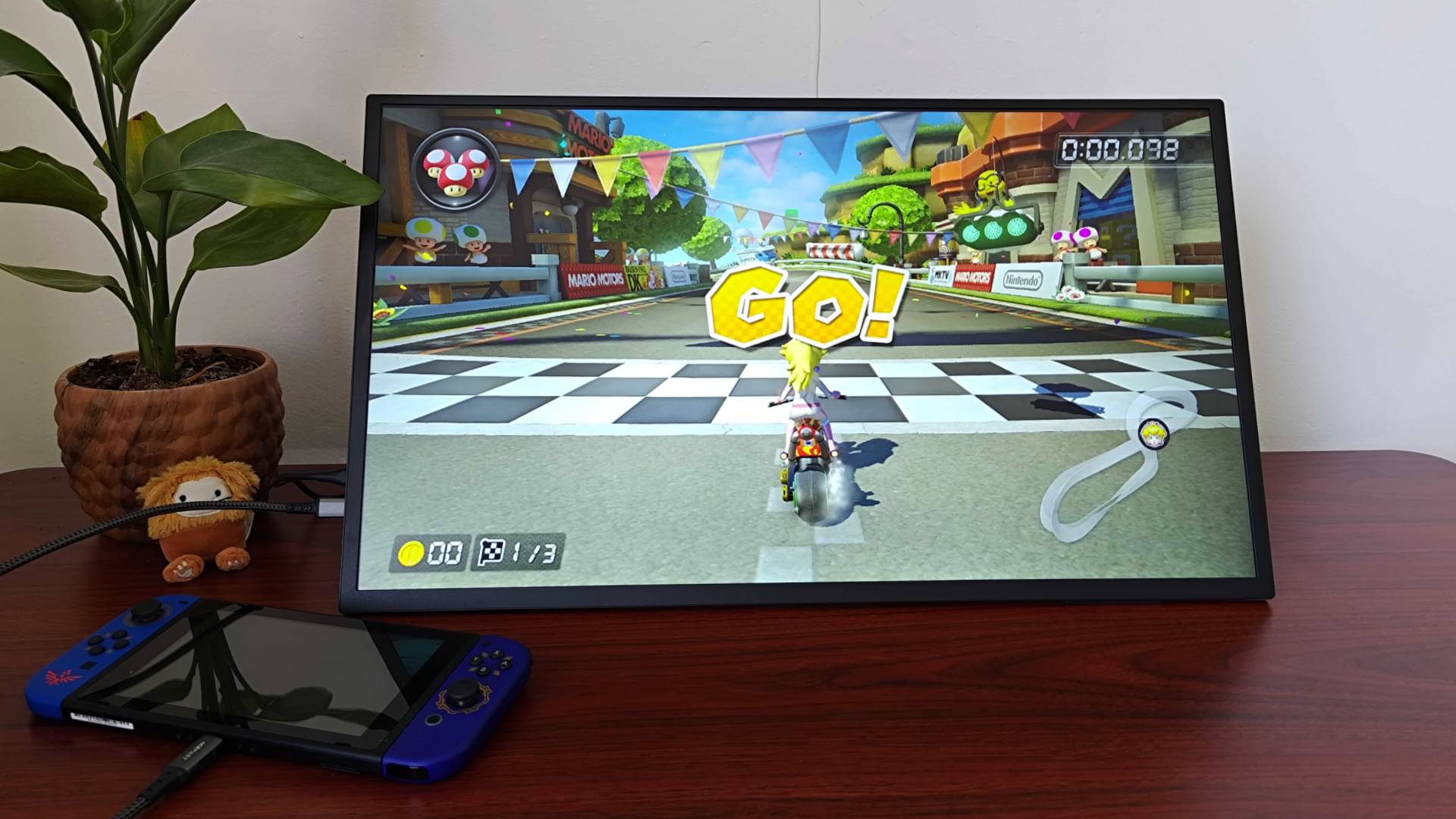GamesRadar+ Verdict
The Uperfect Umax 24 is one of the largest portable monitors around, but it makes to pull off being lightweight while providing punch 1440p 165Hz visuals. It’s designed to blur the lines between desktop and mobile screen, but it ultimately serves players looking for a large lightweight display for handhelds and laptops that comes with less compromise. When the Switch 2 lands, I reckon this panel is going to become even more popular.
Pros
- +
Surprisingly light
- +
Massive 24.5-inch panel
- +
Sharper 1440p visuals
- +
Speedy 165Hz refresh rate
- +
Full USB-C capabilities
Cons
- -
Isn't going to fit in your backpack
- -
Not as bright as desktop screens
- -
Needs some settings tweaks out the box
Why you can trust GamesRadar+
Hats off to the Uperfect Umax 24, as this screen has me questioning what a portable monitor actually is. Unless you’re one of those wandering merchant Gorons from Zelda: Wind Waker, there’s fat chance this 24.5-inch display is going to fit in your backpack. Yet, I genuinely believe this might be the ultimate travel panel for handhelds like the Steam Deck and even the Switch 2, especially if you’re looking for slightly beefier specs.
I grew up during a time when “portable” TVs were all the rage, and that was really just shorthand for a heavy CRT with a handle. So, even though 24.5 inches feels absurd, I’m going to argue the Umax 24 is still a best portable monitor contender. No, it’s not going to slide into the laptop compartment of your tech bag, and it uses its own carry case, but it’s still a 1440p 165Hz display that is way easier to take with you than a desktop model.
The catch? Well, slimming down a QHD display like this isn’t cheap, as the Umax 24 will set you back $459.99 / £462 at full price direct from Uperfect (also available at Amazon). At first, that MSRP did give me the ick, but now that I’ve spent some good quality time beaming its visual into my eyeballs, I’m not entirely offended by the price tag. Still, it’s anything but affordable, and it’s an investment that isn’t going to suit every player universally.
Price | $459.99 / £462 |
Screen size | 15.6-inch |
Screen type | IPS |
Resolution | 2560 x 1440 |
Refresh rate | 165Hz |
Brightness | 250 cd/m2 |
Response time | 10ms |
Viewing angle | 178° |
Contrast ratio | 1000:1 |
Color support | 16.7M colours |
Inputs | 2x USB-C, 1x HDMI 2.0 |
Weight | 2.64 kg (5.83 lbs) |
Design
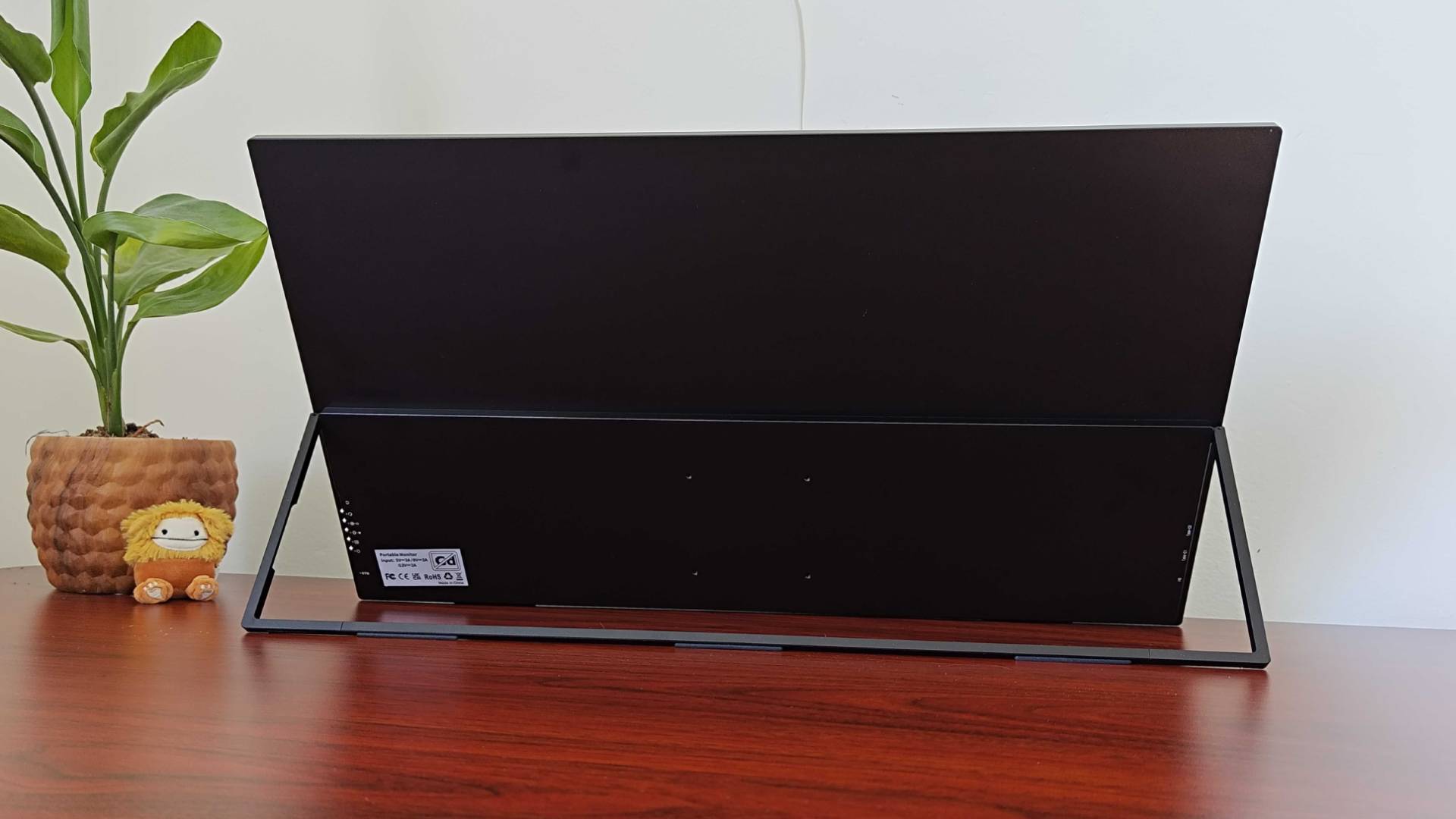
I hope you like big rectangles, cause that’s effectively what the Uperfect Umax 24 is. I guess that’s only a half-joke since when you’re trying to make a 24-5-inch gaming monitor portable, it makes sense to forgo anything style elements that will add bulk in the name of aesthetics. Plus, if I’m being real with you, almost every screen to release these days is merely a thin frame around a panel, so most of the fair ends up partying around the back.
I’ll give Uperfect their due, the Umax 24’s bezel is pretty thin. You’d think a 24.5-inch screen with no real booty would need some thick edges to accommodate its guts. But nope, the borders are respectably slimline and don’t really distract from the panel. I would have honestly given the display a bit more of a pass if it happened to add some width to its perimeter, so I’m happy with what has actually been achieved.
Circling back to that aforementioned party, the back consists of a slightly raised bottom that keeps the ports and buttons to the sides. Again, I fully expected Uperfect to need more space for the internals of this screen, but instead it has Tetris’d everything into a 0.63-inch-thick body. Ultimately, it’s by keeping things this thin that the Umax manages to earn portable monitor status despite being pretty massive.
On the left side, you’ll have access to two USB-C ports, one of which you’ll use to power things, and a mini HDMI. It’s perhaps down to your own personal preferences whether having cables firing out the side is an ick or not, but the solution is to use some ring-angled adapters.
Weekly digests, tales from the communities you love, and more
The OSD buttons live on the right, and while the metal toggles are slightly cheap and rattly, they’re miles better than what I’d had to use with other portable screens. There’s a bit of a trend of cheaper display makers using a pivoting wheel for moving up and down, and my thumbs are still trying to get over the pain of the cheap plastic.
By separating each button, Uperfect has at least made it so you don’t have to deal with all-in-one solutions that feel far worse and can lead to frustrating mispresses. My biggest gripe here is that there’s no visible labling on them to actively tell you what you’re pressing, and while I get that printing symbols would look garish, I’d have taken even some embossed hints.
Rather than having to figure out how to prop this massive screen up or make use of its VESA mount on the back, you’ll be able to use its built-in kickstand. It’s pretty simple since it consists of a rectangular metal frame on a hinge, but it feels solid enough to get the job done. I’ve moved it back and forth to try and get a sense of whether it’ll slacken off over time, something that could cause absolute havoc, but it feels like it’d take a lot to make it loose.
Features
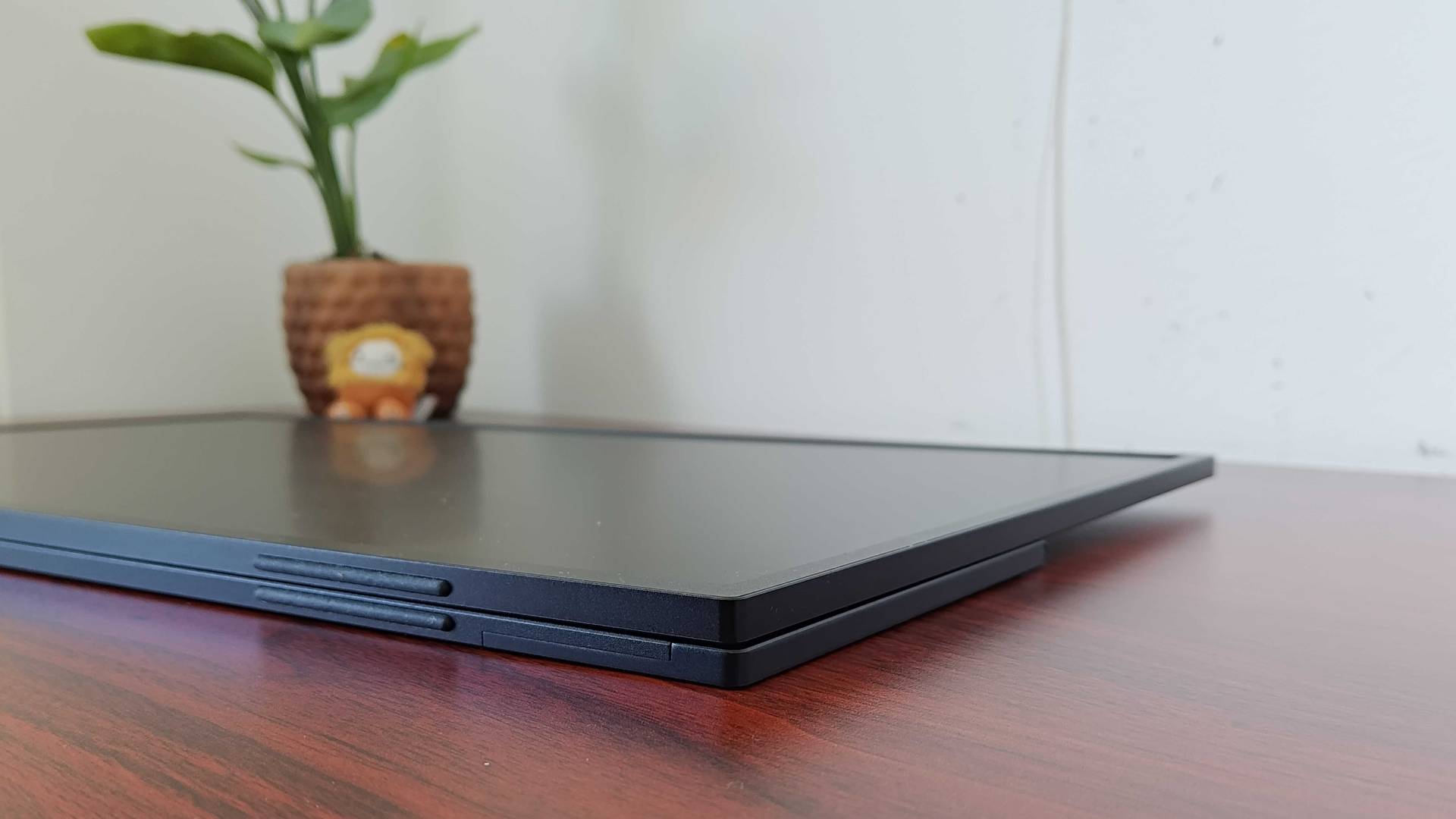
In 2025, QHD monitors aren’t remotely unique, and with the likes of the Sony Inzone M10S hitting up to 480Hz, lower refresh rates don’t impress me much. Okay, I’ll quit it with the Shania Twain while I’m ahead, but my point is that while I wouldn’t normally consider a 1440p 165Hz screen to be impressive, it becomes something special once you squeeze it into a lightweight package. In case it wasn’t clear, that’s exactly what the Uperfect Umax 24 is doing.
At smaller sizes, I’d argue you don’t really need 1440p to have a good time. But, since the Umax 24 dares to push the portable bar to 24.5 inches, I can see why Uperfect decided to go with a QHD panel. It would have still looked dense enough at a sensible distance even at 1080p, but if you do envision yourself sitting quite close to it in the future, playing something like Metroid Prime 4 on the Switch 2, it’ll look pretty crisp.
The Umax 24 comes armed with a USB-C with Alt DisplayPort functionality, so it’ll be perfect for handhelds and gaming laptops. You’re sadly, but perhaps understandably for weight reasons, not getting a built-in battery here, but the very nature of the setup means you’ll be able to either power the screen using your chosen device, its power adapter, or even a power bank.
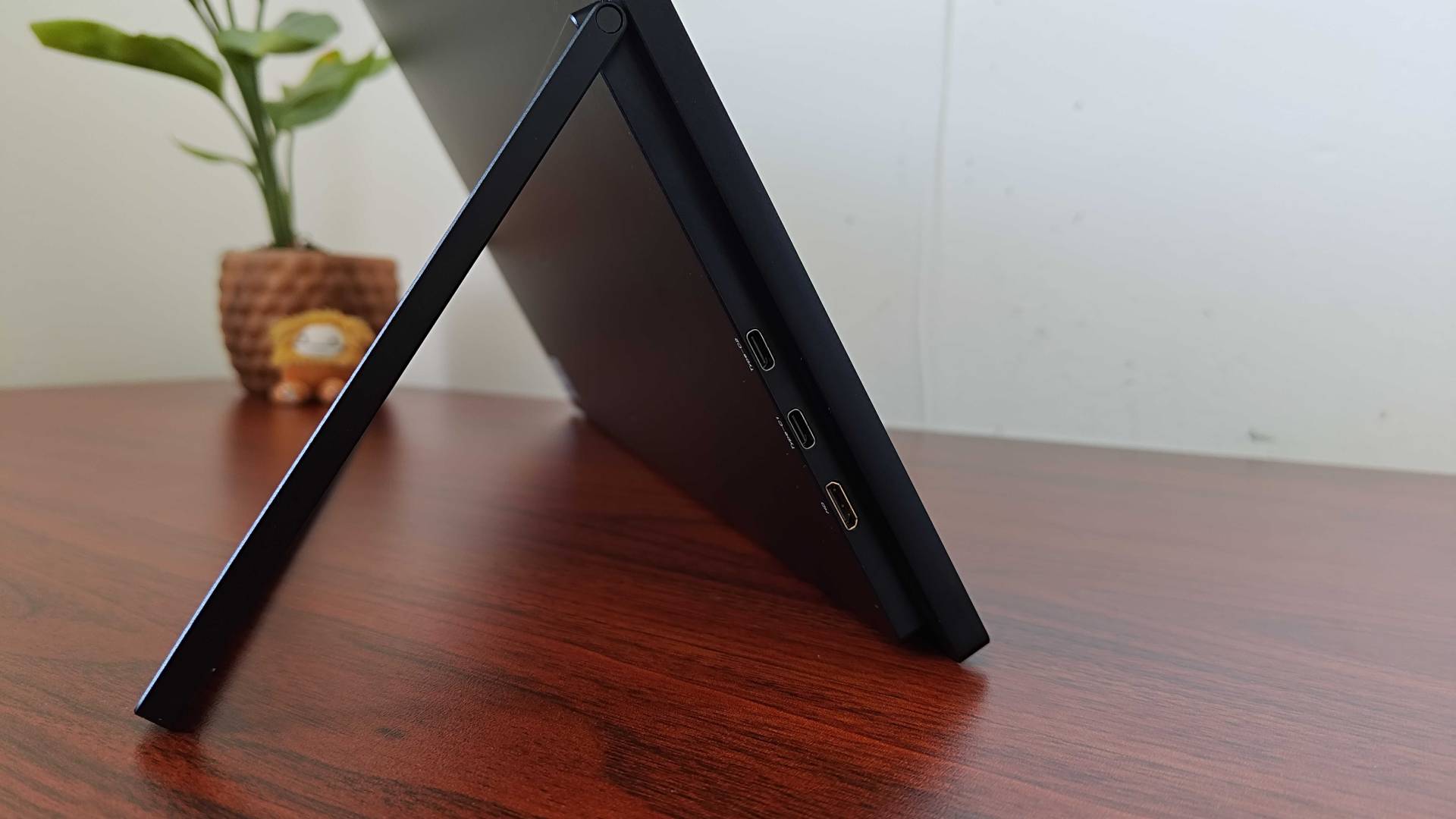
More gaming handhelds than ever are starting to include more than one USB-C port for charging, including the Switch 2, and that will allow you to make something of an interlinked setup. Rather than having separate chargers going into the screen and your device, you can instead feed the latter with an adapter, then use the secondary port to connect to the screen. Provided you’re using an adapter with a beefy enough wattage, that will allow you to keep everything powered to minimise wires, and some power banks could even keep you running without an outlet (albeit for an hour or two at most).
Since mini HDMI is also an option, this screen can also technically serve as a PS5 monitor. You’ll be capped at 144Hz since it’s 2.0, but that’s more than enough to enjoy console shooters at 120fps. Naturally, using Sony’s system or a Xbox Series X is going to hamper the portable side of this display, but if you’re the type of player who’s tempted to grab a PlayStation Portal just so you can play while someone else uses the TV, perhaps a slimline 24-inch monitor is a better living room solution.
If you’re really looking for something that keeps the need for additional wires and extras at bay, you’ll be thrilled to hear the Umax 24 has built-in speakers. They’re not remotely punchy, and the 1W set might struggle to cut through noisy environments. That said, they’re perfectly serviceable if you just need to hear what’s going on or you’re pitched up somewhere without hussle and bustle. Let’s face it, no one at your local coffee shop wants to hear characters shouting nonsense in Mario Kart anyway.
Performance
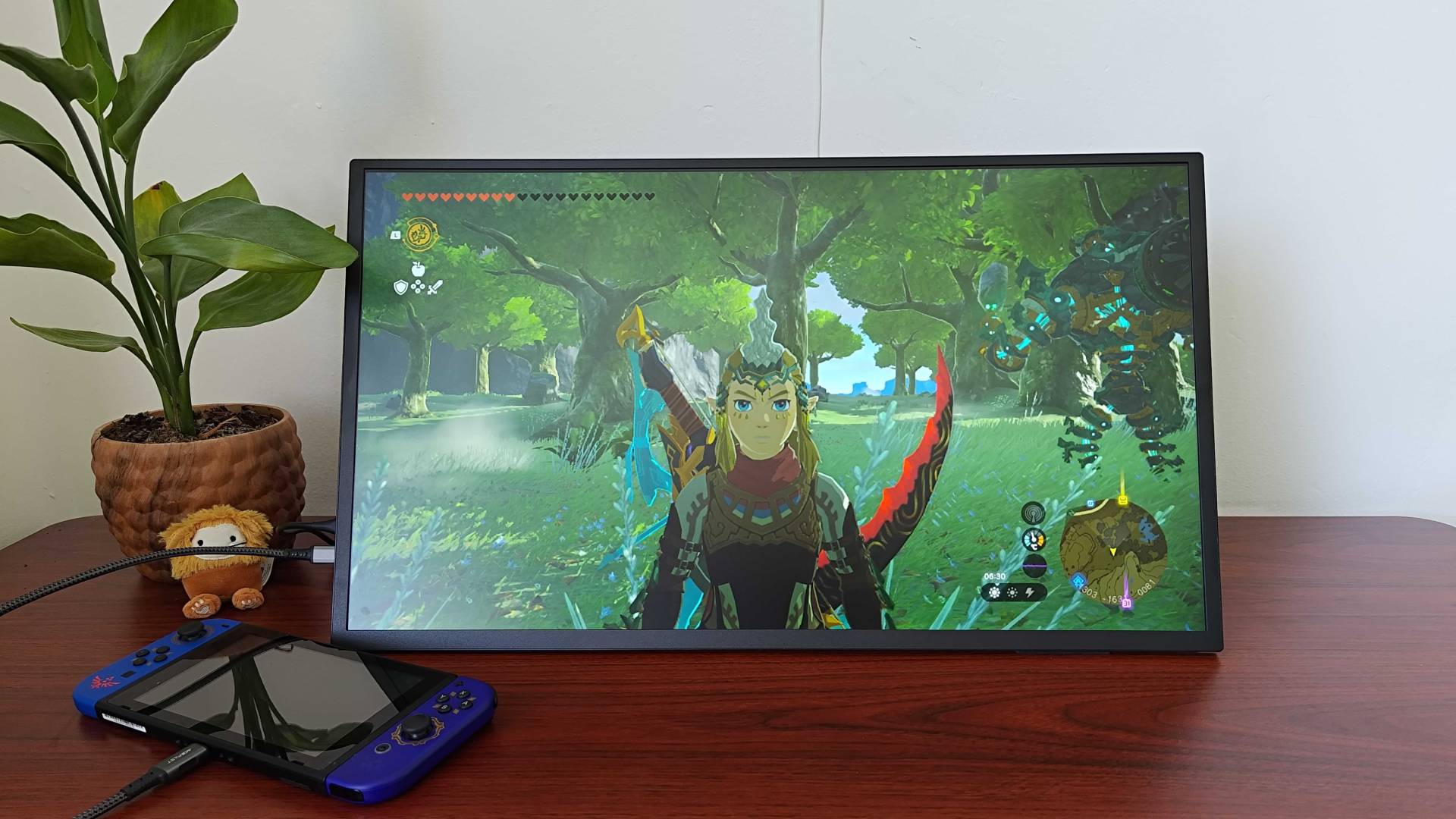
I’ve spent a couple of weeks using the Umax 24 with handhelds and consoles, and while I was originally sceptical about its size, it’s safe to say this massive portable monitor is useful. This is a screen that’s designed to help you feel like you’re using an ordinary display while away from your desk, and while there are drawbacks tied to its portability, they’re outweighed by the panel’s pure versatility.
I’ll get some of the cons out of the way first since they’re pretty straightforward. The first drawback I noticed upon firing up the panel settings need a lot of manual tweaking out of the box. In Cyberpunk 2077, default contrast levels really didn’t get along with the neon-soaked gloom of Night City, but I was able to make things a little easier on the eyes by cranking up contrast, playing around with black levels and saturation, and ensuring that HDR is firmly off.
Technically, this screen has an HDR mode, you’ll want to leave it off in most scenarios. The Umax 24 doesn’t have the brightness to back up its supposed High Dynamic Range abilities, and using them risks undesirable contrast levels. Don’t get me wrong, the feature might prove useful depending on the game, as the Switch 2 might have good optimisation for lower HDR brightness since Mario Kart World will take full advantage of it in handheld mode, but that remains to be seen.
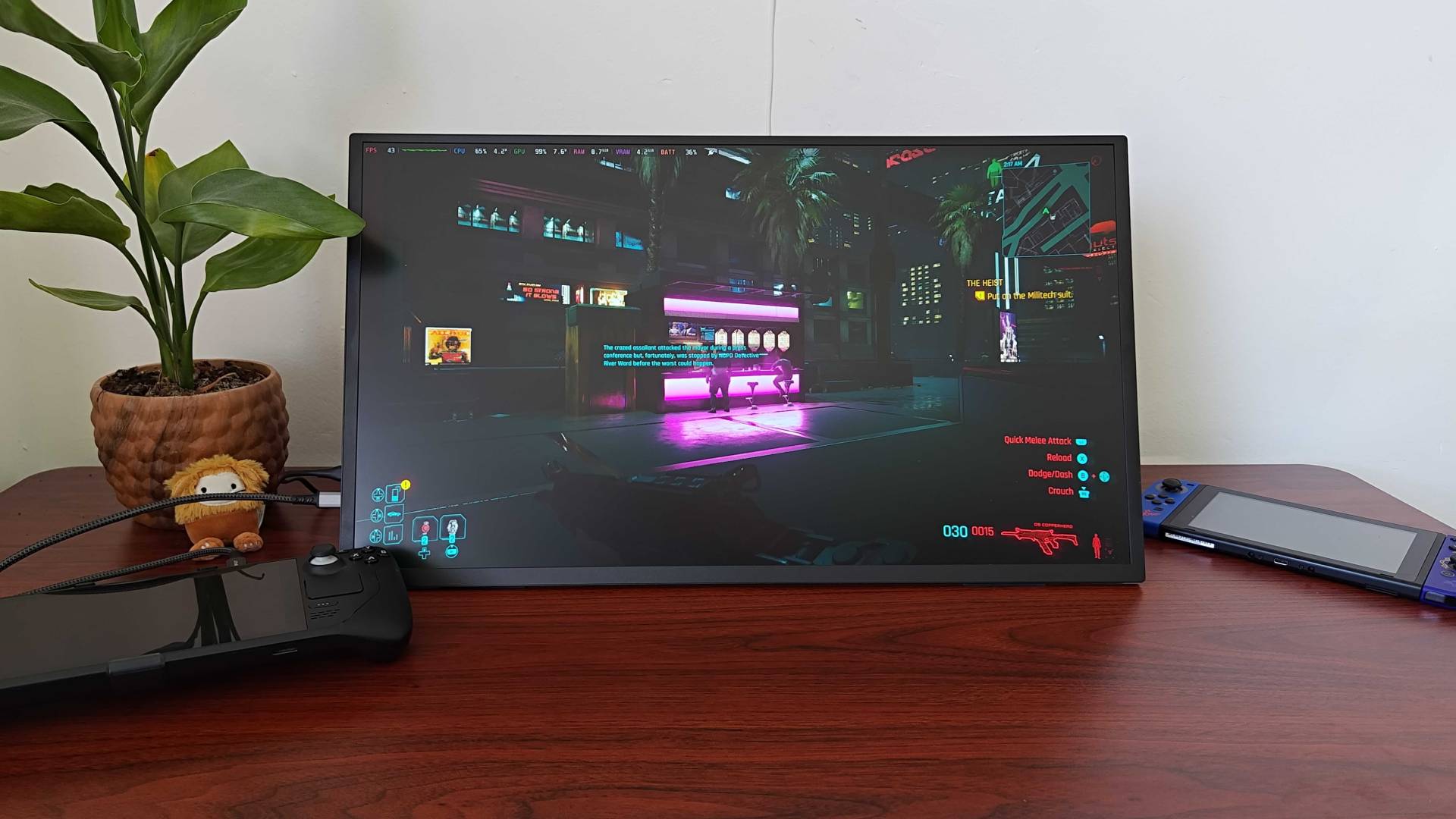
My other reservation is that balancing settings on the Umax 24 in general can be tricky. To help the panel look its best in all scenarios, you might have to use different levels each time, and the built-in presets don’t set things exactly how I’d prefer them. You’re more likely to notice this when jumping from a darker environment to somewhere more vibrant, as if you’ve been messing with the contrast dial, things might look a little oversaturated.
Alright, let’s talk positives, as the Umax 24 has a lot to offer players looking for portability. First off, this is a pretty crispy QHD screen, and 1440p looks nice and sharp across 24 inches. If you’re using a handheld like the Steam Deck OLED, demanding RPGs like Cyberpunk 2077 aren’t going to look fantastic since FSR and lowered settings will make things look grainy. But, the second you switch to something lighter like Tomb Raider Trilogy or an indie that can run at native resolution without compromise, you’re cooking.
I’m actually already excited about using the Umax 24 with the Switch 2 since it feels like such a good match for the OG version. I’ve spent some time playing Mario Kart 8 and other Ninty outings on this panel, and I’m pretty surprised at how well it scales to 1440p. Colors are all respectable, although of course a little muted compared to OLED screens, but there’s nothing that screams “I’m just a wee portable monitor with limited abilities” going on. Simply put, I’d just assume this was an ordinary desktop display if it were mounted to a pedestal stand.
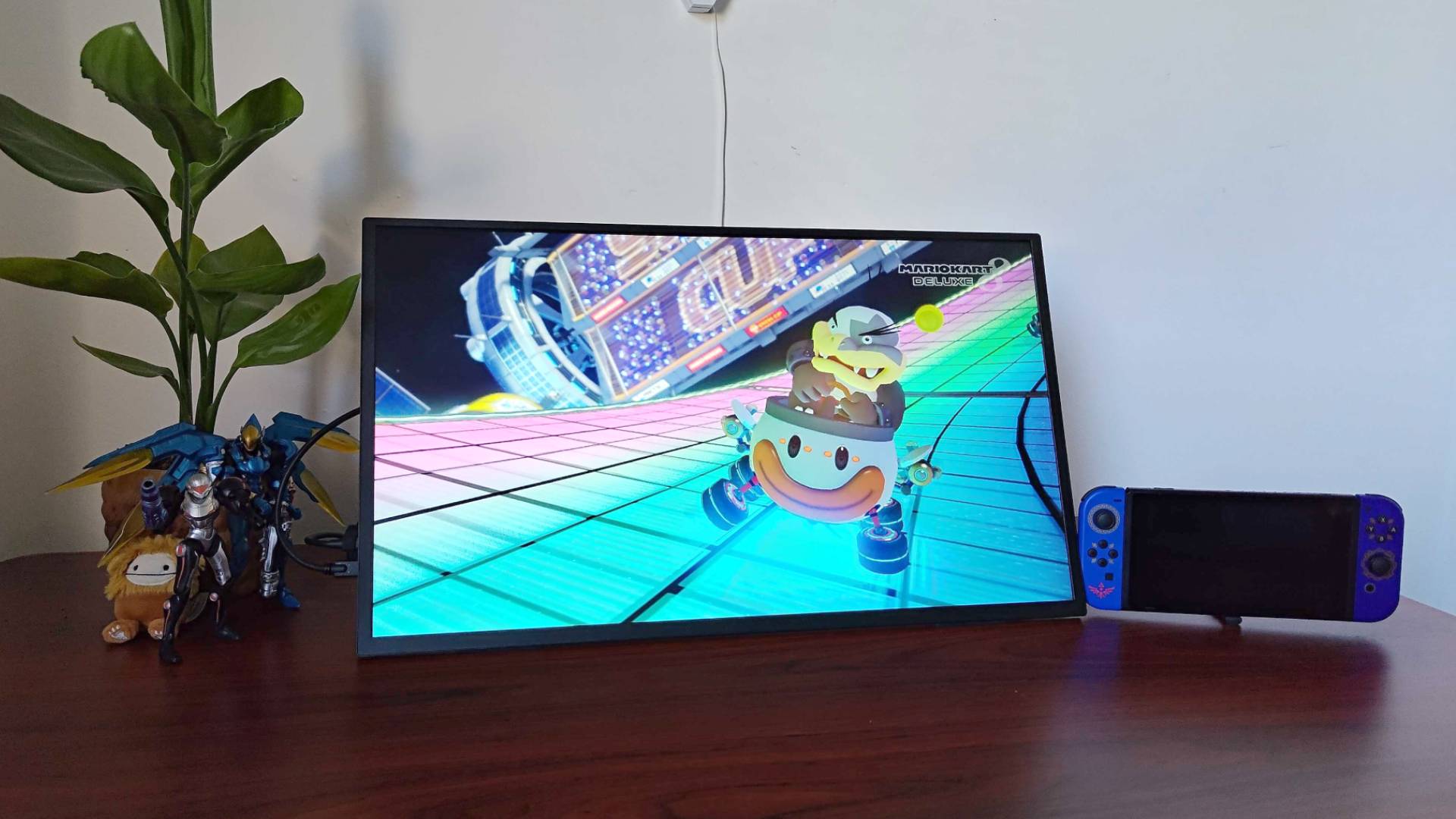
Please don’t roll your eyes when I say this, but I’m a big sucker for the whole “cosy gaming” aethstetic. You know, the thing that’s purely vibes based that is a phenomenon on Tiktok and Instagram? I’m fully invested in that. The Umax 24 seems to be too since it’s practically serving as a proper gaming screen you can pitch up anywhere, including on your bed with cute blankets and cups of tea. Yes, I’ve been spending a lot of time tackling my Steam backlog doing just that, playing everything from the Runescape-inspired, bug-themed RPG FlyKnight to Disco Elysium and Stardew Valley.
At the same time, I wouldn’t remotely grumble if I had to use the Umax 24 as my main display. It hits many of the same notes as other IPS QHD panels, and slimming things down doesn’t notably impact vibrancy. Brightness is the only pitfall that really stands out, but the gap between this portable monitor and a 1440p contender like the Lenovo Legion R27qe isn’t massive enough for me to care.
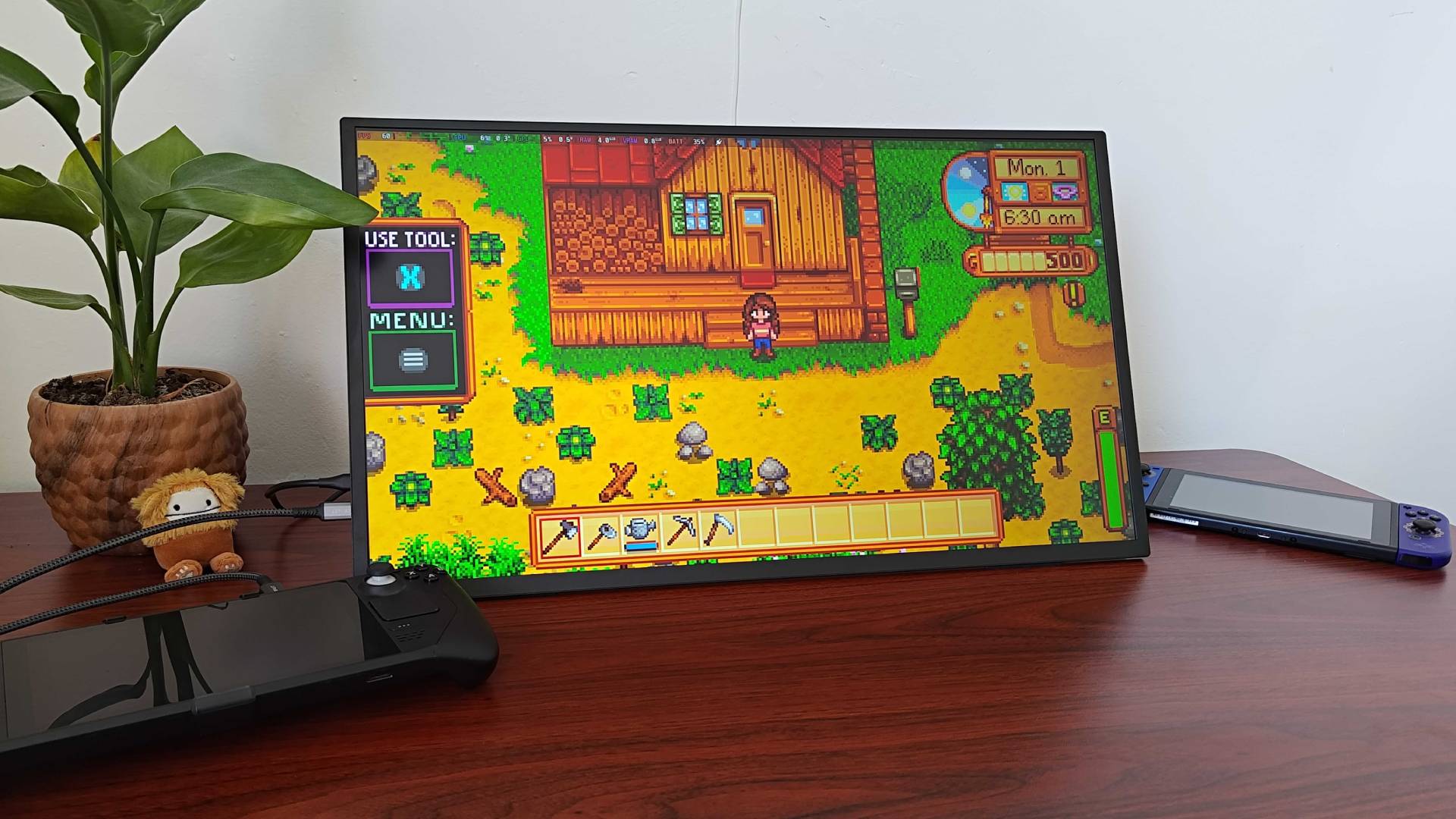
I’m also a big fan of the Umax 24’s 165Hz abilities, even if I wouldn’t use this portable monitor for proper competitive gaming. It’s going to feel slick enough in ordinary adventures, and I’d happily play a few rounds of Overwatch 2 on this screen. However, response times sit around 10ms, which isn’t ideal if you’re looking for super reactive results when they matter most.
Let’s be fair, though – if you need that level of competitive performance, you’ll likely be using a gaming laptop with a display tailored to those needs. Portable monitors, especially models that dare to hit 24 inches, are better suited to both general use and secondary play. The fact you can hit 1440p 165Hz on this panel is impressive enough, and while there are more responsive options out there, like the Asus ROG Strix, you’ll be paying the same price for a 17-inch screen and still only get 3ms as a result. For context, the fastest OLED panels tend to hit 0.03ms, so the tradeoff isn’t quite getting you to an esports sweet spot.
Should you buy the Uperfect Umax 24?
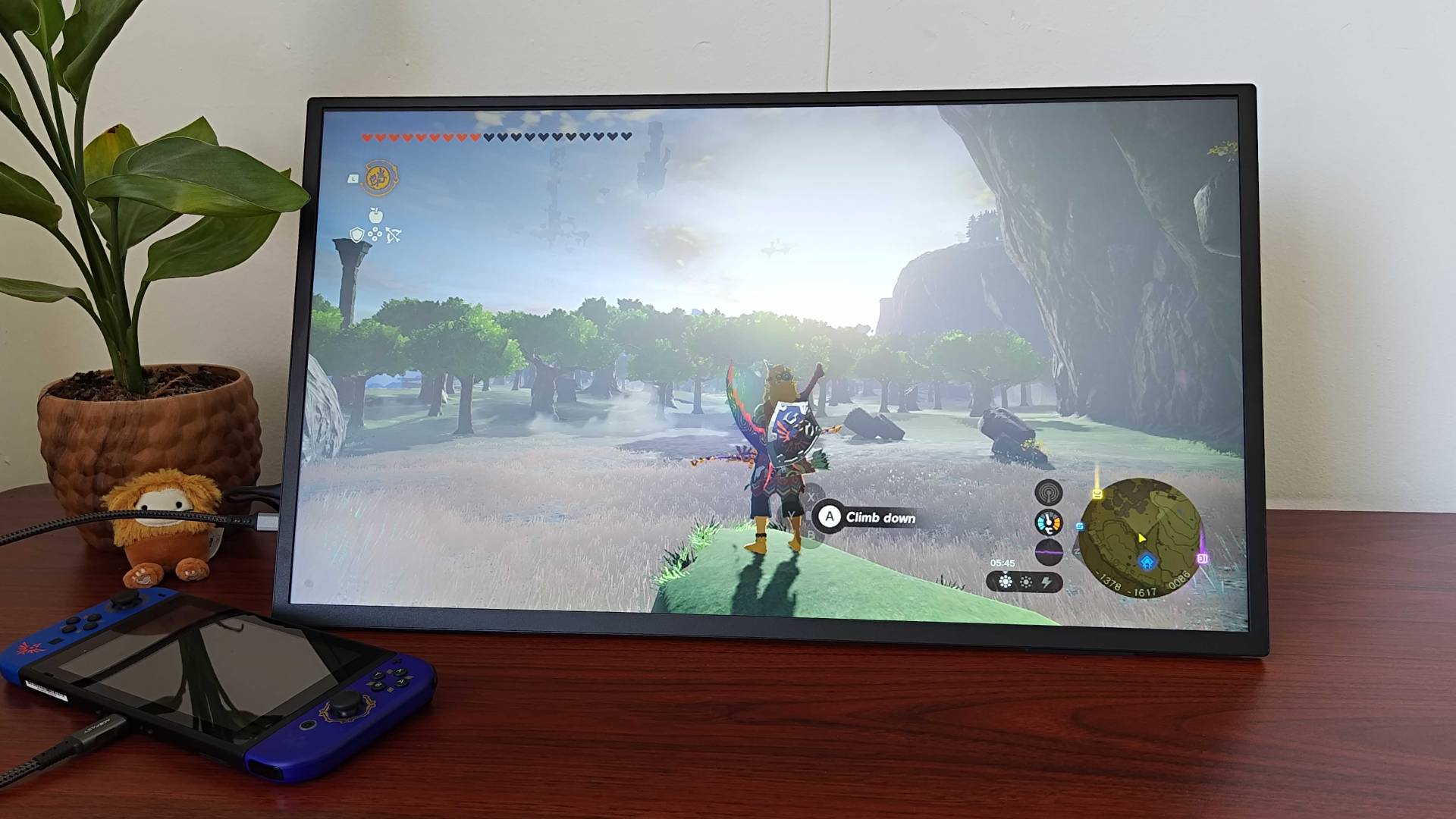
The idea of a 24.5-inch portable monitor may sound daft, but the Uperfect Umax 24 uses its large stature to serve as a versatile gaming screen. While it’s not small enough to slot neatly into the laptop compartment in your bag, bringing this display with you in its carry case isn’t going to weigh you down, and its USB-C capabilities mean you can get away with using a single power adapter or power bank.
Naturally, the Umax makes some compromises to achieve a slim body, but it’s all in the name of being both low powered while still providing impressive QHD 165Hz visuals. What I will say is that since it costs $459.99 / £462, you’ll want to think carefully about whether you need a screen this size for taking on the go or if a much cheaper alternative with basic specs will do the trick.
Will other smaller portable monitors pull off the same moves as a multiplayer Mario Kart screen over the summer? I’m not convinced, but if you’ve not got any big plans for a lightweight screen, keeping costs down makes sense.
How I tested the Uperfect Umax 24
Over the course of two weeks, I used the Uperfect Umax 24 to play games using the Steam Deck, Nintendo Switch, and a desktop gaming PC. During that time, I spent time using everything from Mario Kart 8 Deluxe to Cyberpunk 2077 and lighter indie games to test the panels 1440p 165Hz capabilities while assessing the screen’s fidelity, colors, responsiveness, and brightness. I also spent considerable time testing the portable monitor in realistic scenarios so as to check its usability and built quality.
For more information on how we test gaming monitors, swing by our GamesRadar+ hardware policy.

Phil is currently the Hardware Editor at GamesRadar+ who specialises in retro gaming, the best gaming handhelds like the Steam Deck, and more modern components like graphics cards. Having spent years offering up classic console advice and over a decade as a gaming journalist for big names like TechRadar, The Daily Star, the BBC, Den of Geek, and many more, Phil now dedicates their days to covering the latest news and offering up invaluable setup advice.
You must confirm your public display name before commenting
Please logout and then login again, you will then be prompted to enter your display name.
